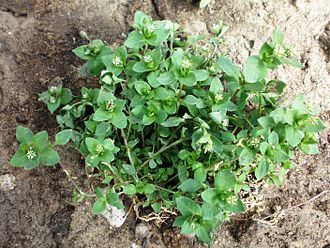Especialidades JA/Agricultura/Respuestas
1
2
- Clay
- Clayey soils are made from very fine particles which stick together easily. Water does not easily soak through clayey soils, but once it penetrates, the clay holds it well. It must be broken up before it can be used for agriculture. This can be done by mixing it with sand, sawdust, wood chips, lime, or manure. Crops that grow well in clayey soils include celery, wheat, oats, beans, and clover.
- Sand
- Sandy soils are made from coarse particles. Water soaks into sand quickly, but will not remain there for very long. This can be addressed by adding clayey soil to it. Crops that grow well in sandy soil include melons, cucumbers, peaches, peanuts, and beans.
- Loam
- Loam is soil composed of sand, silt, manure, and clay in relatively even concentration (about 40-40-10-10% concentration respectively). Loams are gritty, plastic when moist, and retain water easily. They generally contain more nutrients than sandy soils. In addition to the term loam, different names are given to soils with slightly different proportions of sand, silt, manure and clay: sandy loam, silty loam, clay loam, sandy clay loam, silty clay loam, and manural loam. Loam soil is ideal for growing crops because it retains nutrients well and retains water while still allowing the water to flow freely. This soil is found in a majority of successful farms in regions around the world known for their fertile land. Crops that do well in loamy soil include barley, turnips, and potatoes.
3
First, wrap each variety seeds in a paper towel. Then dampen the paper towels and place them each inside their own clear plastic bag (such as a sandwich bag or a freezer bag) so that they retain moisture. Do not seal the bags. Place the bags in a warm place. After three days, carefully remove the paper towel from each bag, open it, and count the number of seeds that have sprouted. If you started with 100 seeds as per this requirement, the germination percentage will equal the number of seeds that have sprouted. Write this percentage down for each variety.
La especialidad de Semillas - Avanzado tiene un requisito similar, entonces considere desarrollarlas juntas.
4
Fertilizers can be divided into macronutrients or micronutrients based on their concentrations in plant dry matter. There are six macronutrients: nitrogen, phosphorus, and potassium, often termed "primary macronutrients" because their availability is usually managed with NPK fertilizers, and the "secondary macronutrients" — calcium, magnesium, and sulfur — which are required in roughly similar quantities but whose availability is often managed as part of liming and manuring practices rather than fertilizers. The macronutrients are consumed in larger quantities and normally present as a whole number or tenths of percentages in plant tissues (on a dry matter weight basis). There are many micronutrients (such as boron, chlorine, manganese, iron, zinc, copper, and molybdenum), required in concentrations ranging from 5 to 100 parts per million (ppm) by mass.
5
Chenopodium album
| Chenopodium album (Fat hen) | |
|---|---|
|
Where found: Worldwide
Description: Chenopodium album is a fast-growing weedy annual plant in the genus Chenopodium. The standard English name is Fat-hen; other names include white goosefoot, lamb's quarters, pigweed or dungweed, or more ambiguously as just goosefoot.
Control: It may be controlled by dark tillage, rotary hoeing, or flaming when the plants are small. Crop rotation of small grains will suppress an infestation. It is, however, difficult to control with chemical means.
|
 |
Stellaria
| Stellaria (Chickweed) | |
|---|---|
|
Where found: Europe, North America
Description: Stellaria is a genus of about 90-120 species flowering plants in the family Caryophyllaceae, with a cosmopolitan distribution. Common names include stitchwort and chickweed.
Control: Control is difficult due to the heavy seed sets, although herbicides are effective when the plants are small. Common Chickweed is very competitive with small grains, and can produce up to 80% yield losses among barley.
|
 |
6
7
Climate is what to expect. Weather is what you get. Climate is basically a long-term average of what the weather has done in the past.
8
Your log need not be any more complicated than a notebook and pen. You could include information such as:
- Plowing/Discing
- When was it done?
- What was the condition of the soil?
- Cost
- Planting
- Date
- Amount of seed used
- Method (how was the planting done?)
- Cost
- Fertilizer
- When applied
- What kind was applied
- Cost
- Pest Control
- Dates and types of pesticides and herbicides
- Cultivation dates
- Mechanical/cultural controls applied
- Cost
- Irrigation
- Dates
- Rainfall dates
- Cost
- Harvest
- Date
- Yield
9
9a
9b
9c
9d
9e
10
The greatest benefit birds provide to farmers is their voracious appetites for insects.
11
Erosion is the displacement of soil by wind, water, or ice by downward or down-slope movement. It can occur quickly on steep ground - especially if there is nothing growing there. It can be slowed by minimizing the amount of time the land has nothing growing on it. When plowing, discing, or planting, it is best to make furrows perpendicular to the slope of the ground. Plowing straight uphill will cause furrows to act as ever-widening ditches that channel the water quickly away, carrying soil with it. Plowing across a hill instead slows the descent of rainwater and allows it to drop the sediments it picks up rather than carrying it off.
12
References
